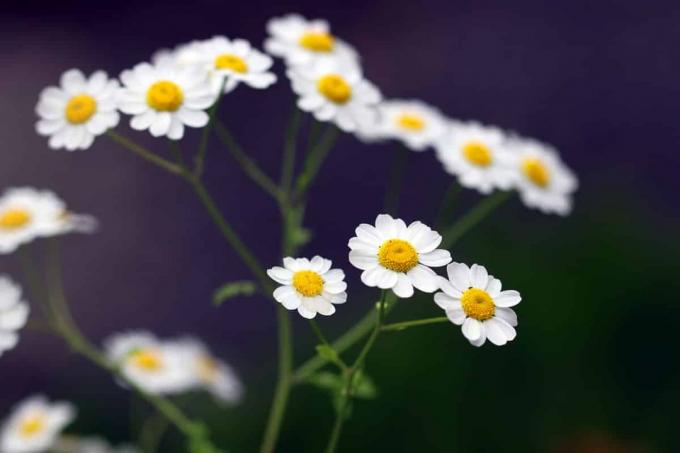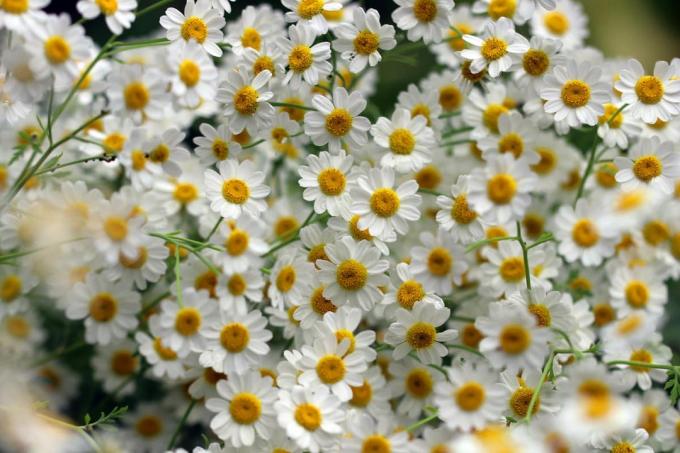

Table of contents
- Characteristics
- sowing
- flowering and flowering time
- fertilizing and watering
- diseases and pests
- tub cultivation
- Plant
- Cut
- location and soil conditions
- hibernate
- multiply
Feverfew, which looks very similar to chamomile, is valued not only as a medicinal herb but also as a decorative ornamental plant in a cottage or natural garden. The easy-care plant needs a lot of sun and is also an eye-catcher in a natural meadow.
Characteristics
- daisy family (Asteraceae)
- bot. Surname: Tanacetum parthenium (syn. Chrysanthemum parthenium)
- also known as "false chamomile", ornamental chamomile or fever herb
- Avoid confusion with real chamomile
- should not be missing in any cottage garden
- Growth height 40 to 60 centimeters high
- white flowers with a yellow cluster
- Flowering period from June to September
- conditionally hardy
- sows itself by seeds over and over again
sowing
Once the feverfew has been cultivated in the garden, it usually comes back again and again in the right location. Because the sowing of the plant does not have to be controlled at all, as it sows itself again every year through the seeds formed. Even if the mother plant has fallen victim to the winter cold. But also a cultivation by a first sowing succeeds:
- Get seeds from stores
- place in pots with potting soil
- best time March
- germinate on windowsill until May
- Temperature around 15 ° Celsius is sufficient
- Germination then two to three weeks
- then place the small plants in the garden bed in May
Tip:
To make a wild meadow even more colourful, you can also sow the seeds directly here in April and May or in the garden bed without having to pull them out. Cover the seeds lightly with soil.

flowering and flowering time
At Chrysanthemum parthenium it is a so-called permanent bloomer. Because once a flower has formed, it will remain on the plant for a long time with the right care.:
- first flowers appear in June
- stay until September
- the flowers resemble those of chamomile
- small, white with a yellow center
- button-shaped flowers about three centimeters wide
- the flowers give off an aromatic scent
- Confusion can be avoided due to scent
- Flowers do not smell of chamomile
A notice:
The herb gets its name from its earlier use when it was used to induce labor in pregnant women. A confusion with chamomile could therefore be fatal in some cases. It was named fever herb because of its antipyretic properties.
fertilizing and watering
Good news is that the herb tolerates lime well and therefore simple tap water can also be used for watering:
- Always keep the substrate slightly moist
- only water directly to the roots
- a brief drought is tolerated
- however, water young plants regularly
- on very hot days in the early morning hours
- alternatively water late in the evening
- in the first year with well prepared soil no further fertilization
- fertilize with compost in the spring of the second year
- alternatively or in the pot liquid fertilizer for flowers
diseases and pests
Unfortunately, the young plants are very attractive to snails. It is therefore advisable to lay out a snail barrier from the start when cultivating in a garden bed laid out for several years. A snail fence or another natural barrier against the snails can be used for this. If the plants are cultivated in pots, other pests must be considered:
- aphids
- spider mites
- like to attach themselves to the potted plants
- especially when there is a long drought
- counteract this with appropriate home remedies
- especially when the herb is used as a medicinal plant
- Fungal diseases occur when there is a lack of space
- So don't plant too close together
tub cultivation

Feverfew (Tanacetum parthenium), for example cultivated together with a rose or alone. In this regard, the following should be observed:
- spreads quickly
- put only one plant in a small pot
- create a drainage to prevent waterlogging
- over drain hole
- Gravel, shards or balls of clay
- over this plant fleece
- Fill in half of the prepared soil
- Insert the plant and fill in the remaining soil
- press and pour well
Plant
Small plants in pots, which can then be planted out in the garden bed, are available in well-stocked specialist shops. The best time to do this is spring, when the ground is no longer frozen:
- four plants are enough for one square meter
- here the feverfew spreads
- covered the entire area after a short time
- Dig a planting hole
- Plant as deep as in the pot
- fill in prepared soil
- press well
- water well
Tip:
The ornamental plants also look particularly beautiful on a bed of roses. Here they can cover the earth between the tall rose plants.
Cut
The plants should always be cut when self-seeding is to be prevented. Because the plant can quickly multiply throughout the garden:
- Always cut faded flowers immediately
- before seeds can be formed
- usually the first time in July/August
- also stimulates flowering
- Cut back to base in spring
- this stimulates new growth
- lignification can be delayed
Tip:
For other plants, you should always leave individual seed heads. So they self-seed and grow back in the same spot the next spring.
location and soil conditions
Finding the right location for feverfew is actually easy. However, a few things should be considered with regard to the soil conditions:
- full sun
- can spread carpet of flowers here
- sunny bed
- on a blooming natural meadow
- Soil may be calcareous
- always keep slightly moist around plants
- Garden soil with compost underneath is sufficient

hibernate
Contrary to many assumptions, it is Tanacetum parthenium a plant that is perennial when the winter climate permits. On the other hand, it also sows itself again and again, the seeds that fall down in autumn can survive on the hardy soil:
- hardy down to -12° Celsius
- protect in harsh regions
- Twigs above the roots help against frost
- lay out in late autumn
- cultivated in the pot a little more protective
- Cover the pot with brushwood
- stand on wood or styrofoam
- Put brushwood on the roots
- put in a safe corner
multiply
In addition to the simple self-sowing, through which feverfew actually becomes a plant, that perennial can survive for many years on the same bed, the plants can also take cuttings be propagated. This propagation is usually well suited for pot cultivation, but also if another bed is to be planted with feverfew:
- choose young, herbaceous shoots
- about 15 to 20 centimeters long
- Do not squeeze the interface
- use a sharp and clean knife
- remove lower leaves
- place the bottom buds in a vessel with water
- put in a bright and warm place
- first roots appear, plant
- ideally in pots
- are plants strong enough to put in the bed in the spring
 garden editorial
garden editorial I write about everything that interests me in my garden.
Learn more about M like mistletoe

Girl's Eye, Coreopsis - Care Tips and Overwintering
With the girl's eye, a summer flower with a likeable feel-good factor moves into the bed. The highly competitive perennial scores with frugal undemanding, coupled with tireless flowering into autumn. Constructive care tips and instructions for overwintering point the way to the successful cultivation of enchanting Coreopsis.

How to properly clean frosted glass – tips against grease stains & Co
Frosted glass or frosted glass, as it is also known, is very popular due to its attractive appearance. In addition, it lets light through, but not unwanted looks. As beautiful as the frosted glass is, one thing has to be taken into account when cleaning it.

Montbretie, Crocosmia - Location, Planting & Care
Like blazing flames, the Montbretia attract attention between soft green tones. The Crocosmia know how to set accents. They bloom tirelessly from July to September in shades of red, yellow and orange. Together with their low demands, the robust exotics have developed into a popular park and garden plant.

Moss Saxifrage - Care, Propagation & Cutting
Moss saxifrage belongs to the low-growing saxifrage species. The characteristic, moss-like growth gave the plant its name. The groundcover perennial is one of the evergreen plants and conjures up color in the otherwise dreary landscape even in winter. Saxifraga arendsii is easy to grow, learn more about the lush growing plant.

Almond trees, Prunus dulcis - care and pruning
White-pink almond blossoms under a bright blue spring sky spread a magic that every hobby gardener would like to experience in their green realm. In order for the frost-resistant almond tree to present its exuberant bloom every year, various requirements for care and cutting must be taken into account. You can find out which aspects are specifically involved here.

Make mistletoe tea yourself: how to dry mistletoe | make tea
Mistletoe has many health-promoting properties and is very suitable for making tea. However, when drying the twigs and preparing mistletoe tea, a few important factors must be observed so that the result is successful and its healing effects can unfold.

